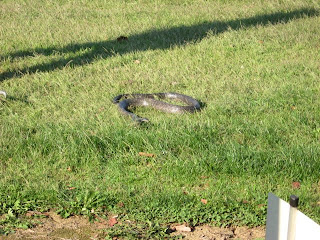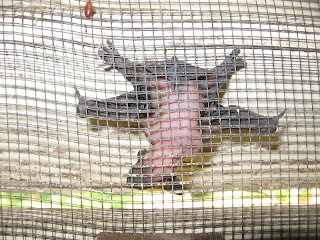
Beaver Double-Take
I own a nuisance wildlife removal business in Ohio, and one of my commercial customers is a small village. The village reservoir is next to a fairly large creek that travels through bottomland before reaching the village.
This bottomland contains a rather high population of beaver. The beaver are fond of traveling up this creek, crawling over the bank, and setting up shop in the village reservoir. The beaver then promptly begin plugging the water plants intake pipes. This is usually when I get the call, and the village rightly expects me to solve the problem immediately.
Usually I get the call during spring, summer, or early fall. However, one particular call came in early December, during our deer gun season, and technically I was on a much needed vacation. This call also just happened to coincide with the day I was fortunate enough to take my biggest buck to date with a handgun.
Between the excitement of taking the deer and showing him off to my friends, I forgot my obligation to remove the beaver from the village reservoir. When it dawned on me that I hadn’t set up on the village’s beaver problem yet, it was a little after 4:15 pm. Now in this neck of the woods it becomes dark about 5:45 pm. The village is approximately 20 minutes from my home, so I had very little time to get sets in before dark. Needless to say I threw my beaver equipment together and took off.
Most of my beaver work takes place when there is open water. I use snares exclusively for open water work. As anyone who has trapped beaver knows, some of the best places to set up on beaver can be hard to reach.
Over the years I’ve developed a set that I use almost exclusively, and it allows me to set up in places that are easier to reach. When the majority of my nuisance calls involves working with clients, it pays to be clean, neat, and professional looking. This can be especially difficult after donning hip boots and struggling around in the mud, without wasting time running back home to shower and change clothes. By setting up in easier to reach areas, I avoid this. I often can set up by only wearing knee boots.
To make this set, I first choose an area that has good visibility from the beaver’s perspective. On a low bank no more than 20 inches high, I use a small shovel to cut a trench up the bank. I make this trench about as wide as what a beaver pullout would be, as this is what I’m trying to imitate. I hang a snare in this trench at the point where the water meets the trench.
Next I cut several 1 to 2 inch diameter sections of wood about a foot long from whatever the beaver are feeding on. I use my hatchet to shave bark from these pieces of wood, allowing the shavings to fall into the trench. I place these wood pieces at the top of the trench with the shaved areas facing the water to visually attract the swimming beaver’s attention. I then liberally rub these wood sections and the trench sides down to about 6 inches above the snare with beaver castor. These castors I collect from beaver I’ve caught at other locations.
I chop these castors into small pieces and place them in pill bottles and freeze. If the water at the set is not flowing I swish the piece of castor around in the water in front of the set. You can watch this oil slick of beaver castor spread out over the water. When finished, this set appears to a swimming beaver as a place where a strange beaver has repeatedly pulled out to feed.
It appeals to their sight (shavings and peeled sticks), and their sense of smell (castor). I’ve heard that beaver in some areas don’t respond well to castor at certain times of the year. It works for me, and I’ve taken the entire population of eleven beaver, with four snare set locations in three nights, in one instance, while using only this set.
By the time I arrived at the reservoir I only had about 45 minutes of light left. I decided to try to get four sets in before dark. As I hurriedly made the last set it was completely dark. Figuring that there were only 2 beaver, I drove home confident I would have them in the morning.
The next morning I arrived at the break of day, so I could remove the beaver before they could be spied by the nearby residents. In this day, it’s often better to do your work discreetly. As I approached the first set, which just happened to be the last set I’d made the evening before, I noticed beaver tracks in the trench. I also noticed the snare was gone. For a second I thought the beaver had dove into the water on my approach, but there was no torn up area indicating a snared beaver. I often attach my snares with cable stakes and a 4 foot section of wire.
This seems to give the beaver room to move about and they seem to fight less. By placing the cable stake far from the water, I keep the beaver out of the water. Because of this, I immediately knew the beaver wasn’t in the water.
I looked across the water at two of my other sets. I could see a beaver sitting in one of them. After taking care of that beaver, I went to check my last set. As I approached the last set I heard a splash, and was rather surprised as I had thought there would only be two beaver. Obviously this was the second beaver, and I still had one around here with a snare and 4 foot of wire attached. As I pulled the beaver out of the water I noticed there was a second snare with 4 foot of wire attached. Yep, you guessed it, this was my missing beaver, snare and all. I’d caught this beaver twice in one night!
Should you need help with a beaver problem in Southeast Ohio, Zanesville or Cambridge or in these counties:Belmont, Coshocton, Guernsey, Harrison, Monroe, Morgan, Muskingum, Noble, Perry & Tuscarawas, OH, visit my webpage at
A All Animal Control.
 Black Rat Snake control and removal increases in the fall due to the snakes seeking a place to overwinter. Black snakes will seek out crawlspaces and basements for their warmth and are a great place to hibernate through the harshness of winter.
Black Rat Snake control and removal increases in the fall due to the snakes seeking a place to overwinter. Black snakes will seek out crawlspaces and basements for their warmth and are a great place to hibernate through the harshness of winter.





